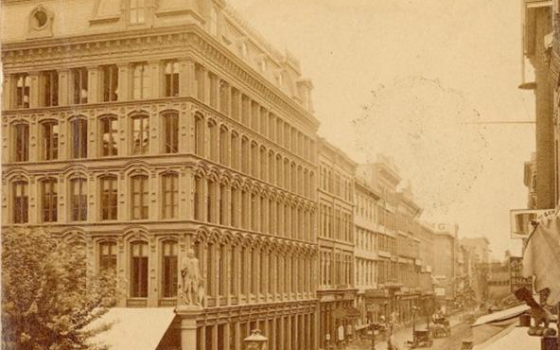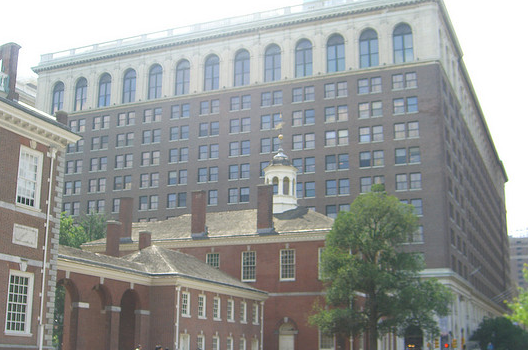Horse-drawn carriages and dusty streets describes the scene in 1870 where Chestnut and 6th Street met at the Public Ledger Building. The Public Ledger began as the first penny paper sold in Philadelphia in 1836. The paper was later purchased by George William Childs in December of 1866, when Childs decided to give the organization a home by purchasing land and erecting the Public Ledger Building. The building was designed by prominent architect of the time, John McArthur Jr., who is best known for having designed Philadelphia City Hall. At the corner of the block, Childs placed an enlarged statue of Benjamin Franklin, which was made by French-American sculptor Joseph A. Bailly. This photo here also befittingly shows horse and carriage, as the Public Ledger was the first daily to utilize the Pony Express.
After going through a series of new owners, the Public Ledger was eventually purchased by Cyrus Curtis in 1913. Curtis decided to reconstuct a new Public Ledger Building directly atop the site of the old building in 1921. For this project Curtis looked to prominent (early 20th century) architect Horace Trumbauer, who chose to design the building in Georgian Revival style. Georgian architecture has several defining characteristics, with one of the most prominent being its use of proportion and balance. Architects utilized mathematical ratios to determine door and window heights, as well as their spacings. Georgian architecture also employs styles derived from ancient Rome and Greece, while at the same time emphasizing the importance of symmetry.
It is the structure designed by Trumbauer which can still be seen today. Not the prettiest building around (exterior wise) I feel as though the new structure lacks a certain character when compared to its predecessor. In admiring this photograph, one notices the artistic similarites the old Public Ledger Building of 1866 shares with Philadelphia City Hall. —-Alex Graziano



Leave a Reply